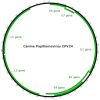Genomic Characterisation of Canis Familiaris Papillomavirus Type 24, a Novel Papillomavirus Associated with Extensive Pigmented Plaque Formation in a Pug Dog
- PMID: 36366455
- PMCID: PMC9693439
- DOI: 10.3390/v14112357
Genomic Characterisation of Canis Familiaris Papillomavirus Type 24, a Novel Papillomavirus Associated with Extensive Pigmented Plaque Formation in a Pug Dog
Abstract
Numerous large dark plaques developed over the ventrum, legs and head of a 9-year-old pug dog over a 4-year-period. Histology confirmed a diagnosis of viral pigmented plaque and a short section of a novel papillomavirus (PV) type was amplified using consensus PCR primers. Taking advantage of the circular nature of PV DNA, 'outward facing' PCR primers allowed amplification of the full sequence. As this is the 24th PV known to infect dogs, the novel PV was designated canine papillomavirus (CPV) type 24. The CPV24 genome contained putative coding regions for 5 early proteins and 2 late ones. The CPV24 open reading frame L1 showed the highest (78.2%) similarity to CPV4 and phylogenetic analysis showed that CPV24 clustered with CPV4 and CPV16 suggesting CPV24 is the third species 2 Chipapillomavirus type identified in dogs. This is the third report of extensive pigmented plaques covering a high proportion of the skin. Both previous cases were caused CPV4 and, considering the high genetic similarity between CPV4 and CP24, infection by these CPV types may predispose to more severe clinical disease. In addition, as plaques caused by CPV16 appear more likely to progress to neoplasia, the detection of a species 2 Chipapillomavirus within a pigmented plaque may indicate the potential for more severe disease.
Keywords: CPV24; canine papillomavirus (CPV); dog; neoplasia; papillomavirus; pigmented plaque; skin; viral plaque.
Conflict of interest statement
The authors declare no conflict of interest.
Figures



Similar articles
-
Genomic Characterization of Canis Familiaris Papillomavirus Type 25, a Novel Papillomavirus Associated with a Viral Plaque from the Pinna of a Dog.Animals (Basel). 2023 Jun 2;13(11):1859. doi: 10.3390/ani13111859. Animals (Basel). 2023. PMID: 37889803 Free PMC article.
-
Detection of six novel papillomavirus sequences within canine pigmented plaques.J Vet Diagn Invest. 2012 May;24(3):576-80. doi: 10.1177/1040638712443360. J Vet Diagn Invest. 2012. PMID: 22529129 Free PMC article.
-
A case of a canine pigmented plaque associated with the presence of a Chi-papillomavirus.Vet Dermatol. 2012 Feb;23(1):76-80, e18-9. doi: 10.1111/j.1365-3164.2011.01007.x. Epub 2011 Sep 1. Vet Dermatol. 2012. PMID: 21883544
-
Papillomaviruses in dogs and cats.Vet J. 2017 Jul;225:23-31. doi: 10.1016/j.tvjl.2017.04.018. Epub 2017 May 3. Vet J. 2017. PMID: 28720294 Review.
-
Canine papillomaviruses.Vet Clin North Am Small Anim Pract. 2011 Nov;41(6):1183-95. doi: 10.1016/j.cvsm.2011.08.003. Vet Clin North Am Small Anim Pract. 2011. PMID: 22041210 Review.
Cited by
-
Complete Genomes of DNA Viruses in Fecal Samples from Small Terrestrial Mammals in Spain.Viruses. 2024 Dec 5;16(12):1885. doi: 10.3390/v16121885. Viruses. 2024. PMID: 39772193 Free PMC article.
-
Genomic Characterization of Canis Familiaris Papillomavirus Type 25, a Novel Papillomavirus Associated with a Viral Plaque from the Pinna of a Dog.Animals (Basel). 2023 Jun 2;13(11):1859. doi: 10.3390/ani13111859. Animals (Basel). 2023. PMID: 37889803 Free PMC article.
-
Full-genome sequencing of dozens of new DNA viruses found in Spanish bat feces.Microbiol Spectr. 2024 Aug 6;12(8):e0067524. doi: 10.1128/spectrum.00675-24. Epub 2024 Jul 11. Microbiol Spectr. 2024. PMID: 38990026 Free PMC article.
-
Phylogenetic analysis of papillomaviruses in dogs from southern Brazil: molecular epidemiology and investigation of mixed infections and spillover events.Braz J Microbiol. 2024 Jun;55(2):2025-2033. doi: 10.1007/s42770-024-01349-3. Epub 2024 May 7. Braz J Microbiol. 2024. PMID: 38710991 Free PMC article.
-
A Universal and Quantitative PCR Strategy for Detection and Epidemiologic Analysis of Canine Papillomavirus (CPV).Int J Mol Sci. 2025 May 6;26(9):4391. doi: 10.3390/ijms26094391. Int J Mol Sci. 2025. PMID: 40362628 Free PMC article.
References
MeSH terms
Substances
LinkOut - more resources
Full Text Sources
Research Materials

